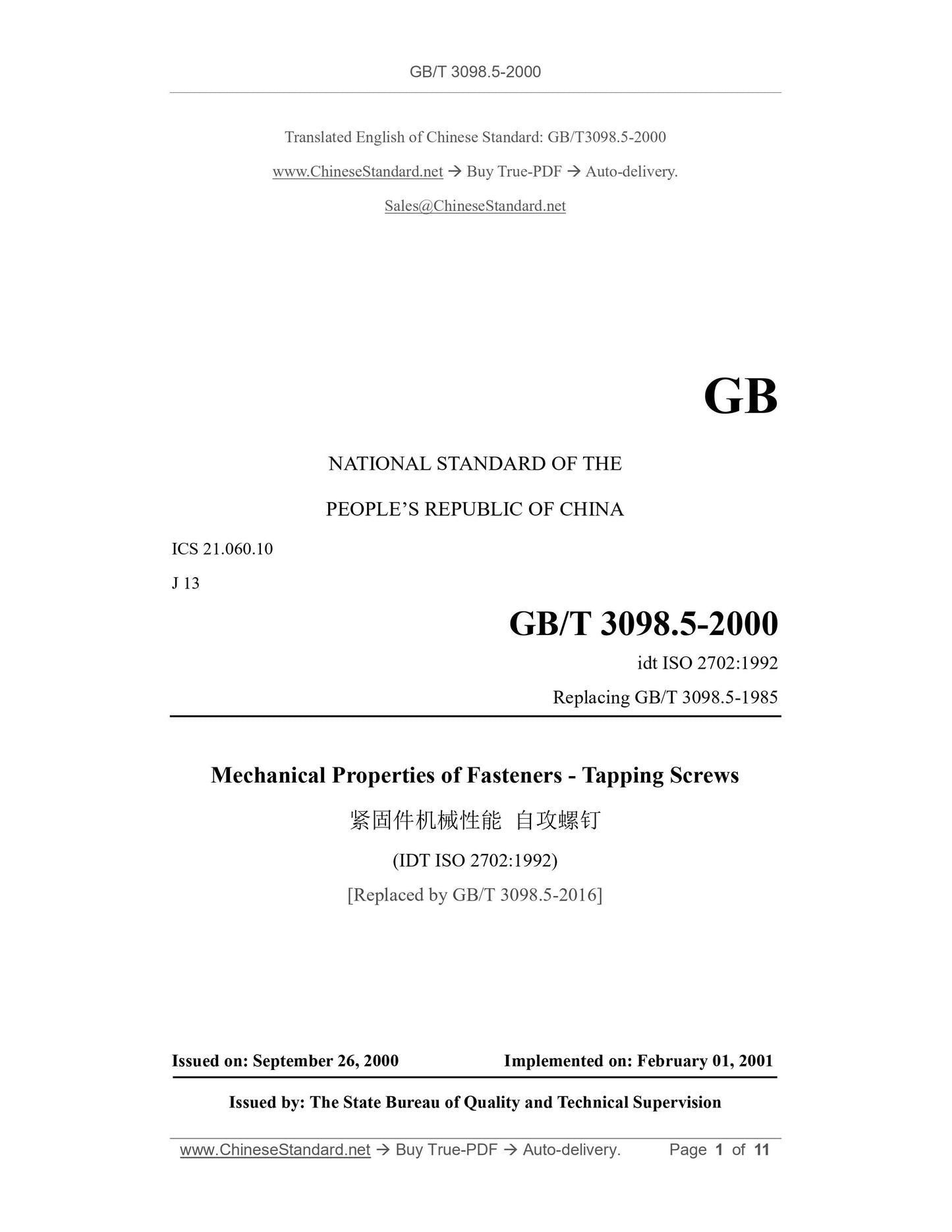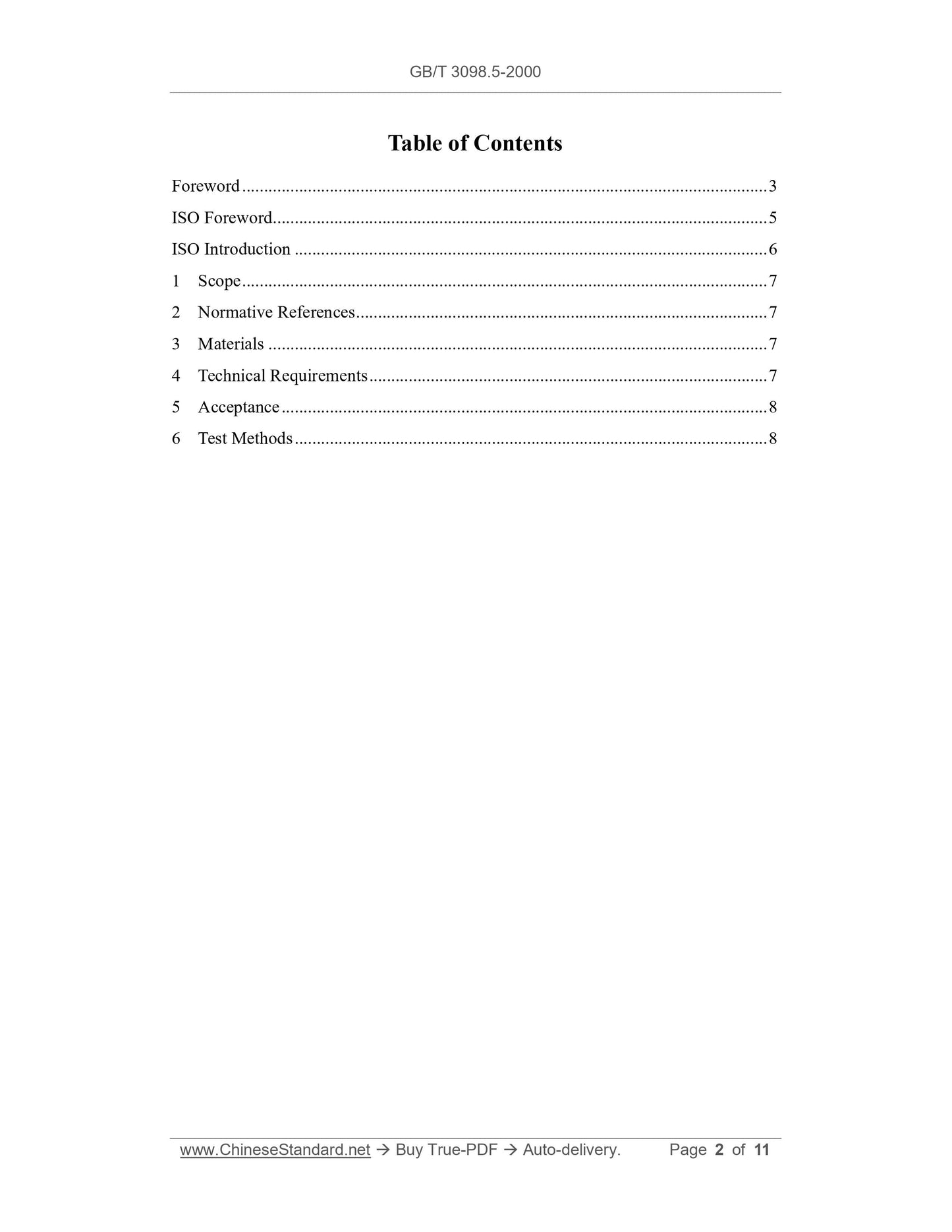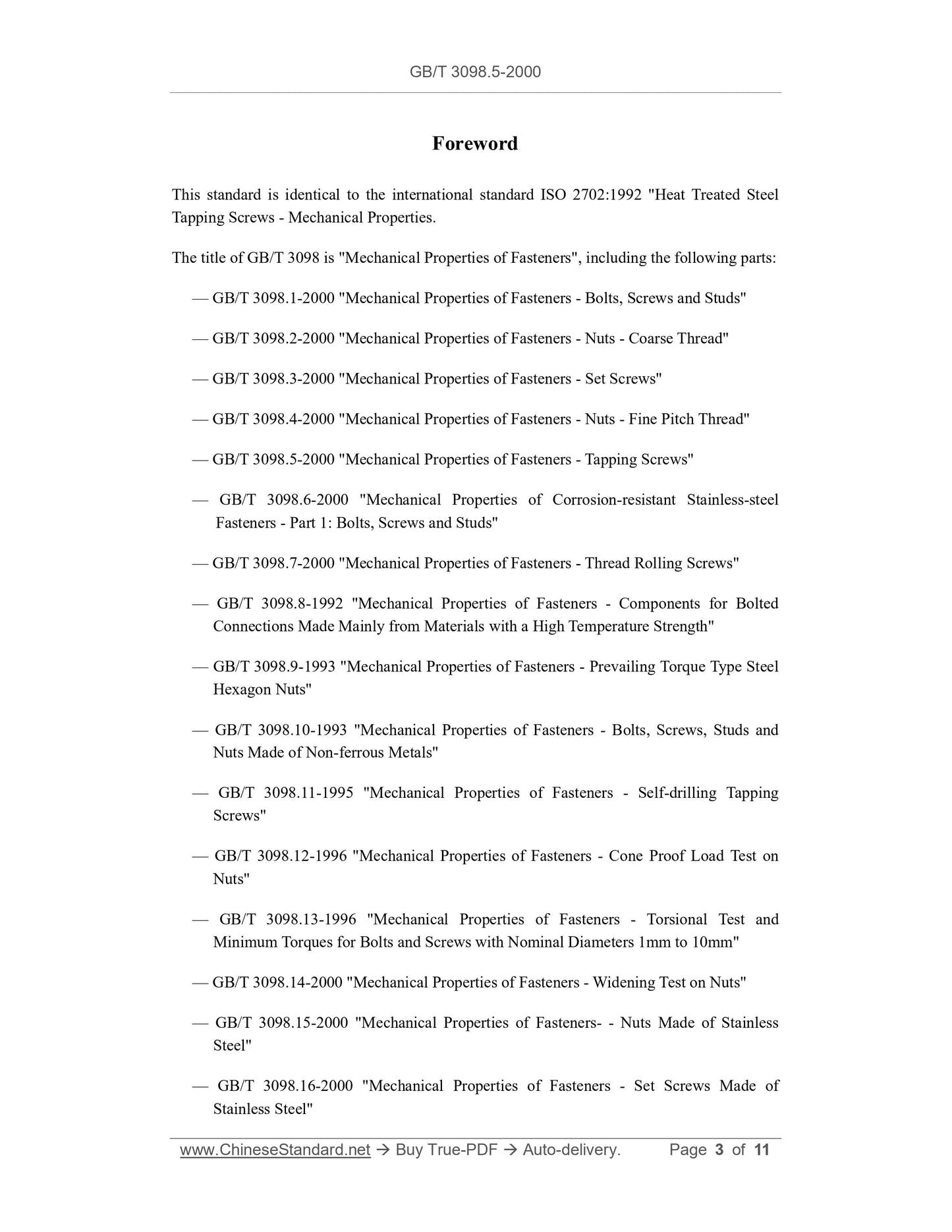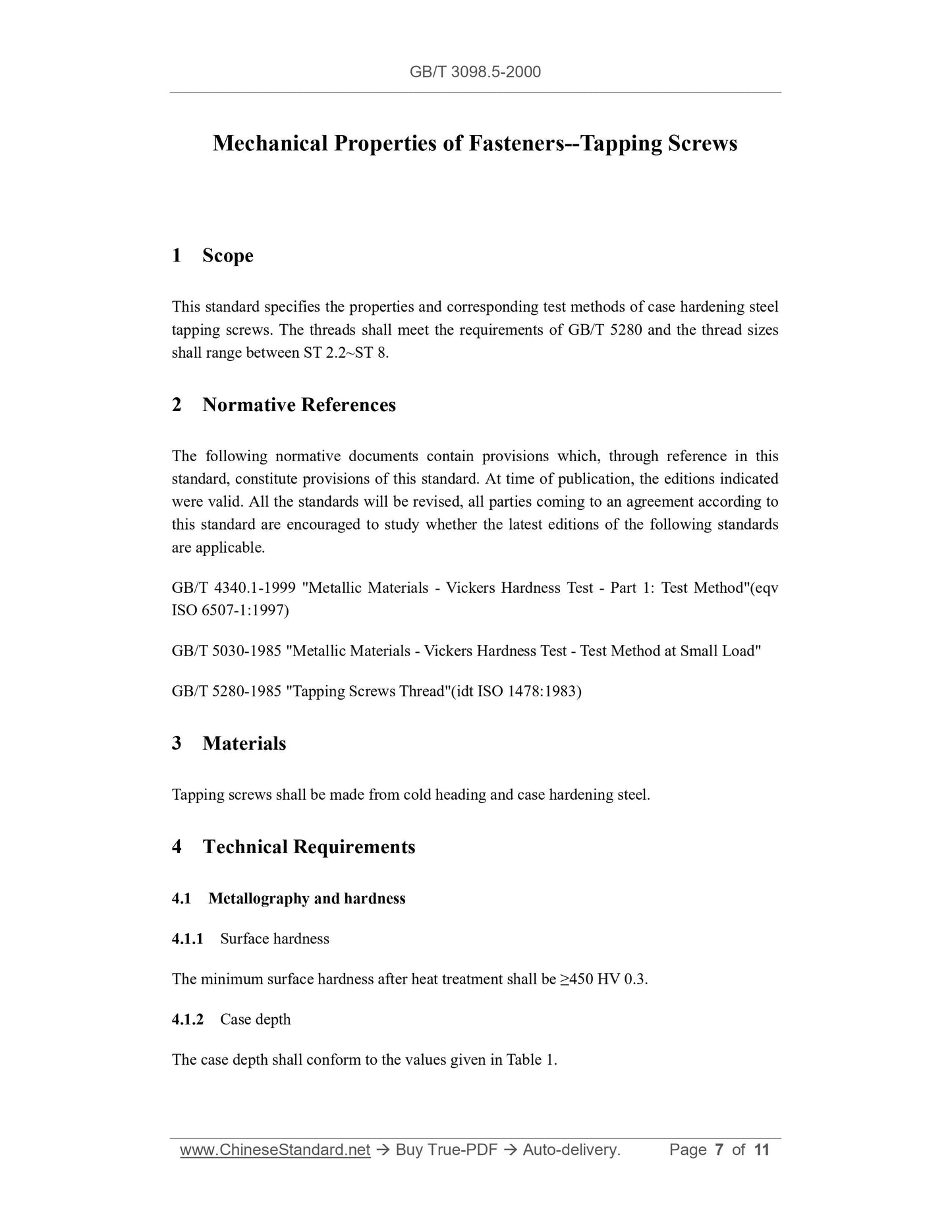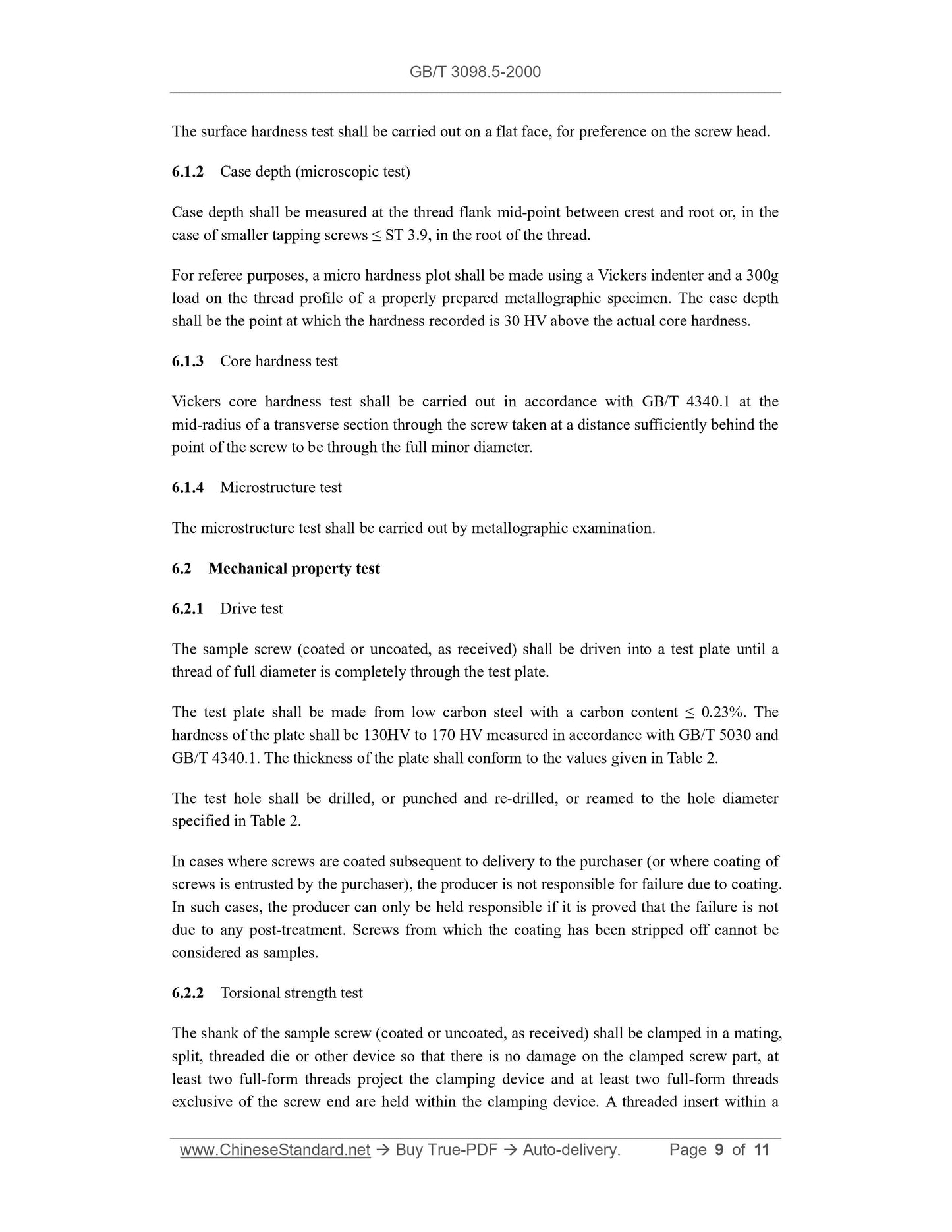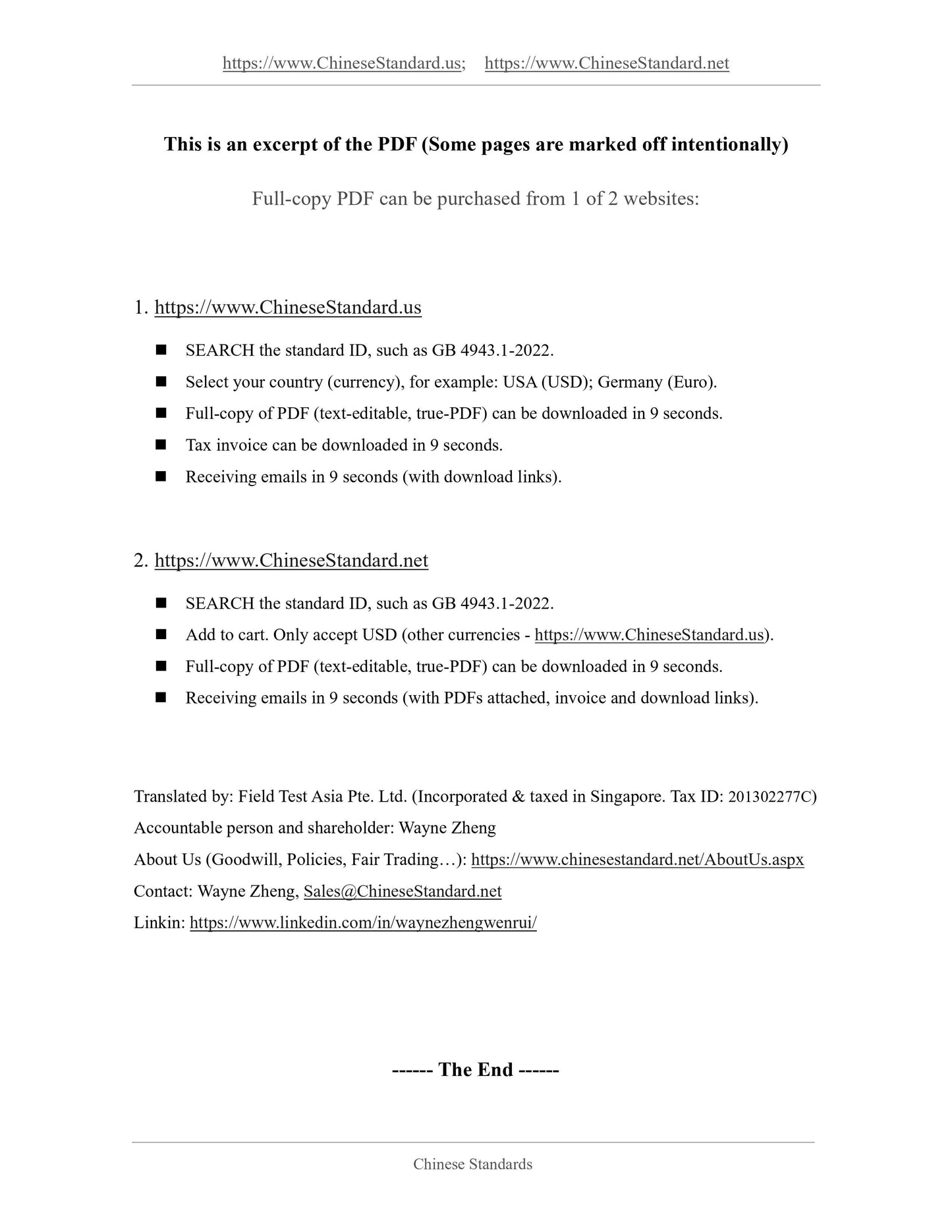1
/
of
6
PayPal, credit cards. Download editable-PDF and invoice in 1 second!
GB/T 3098.5-2000 English PDF (GBT3098.5-2000)
GB/T 3098.5-2000 English PDF (GBT3098.5-2000)
Regular price
$170.00 USD
Regular price
Sale price
$170.00 USD
Unit price
/
per
Shipping calculated at checkout.
Couldn't load pickup availability
Delivery: 3 seconds. Download true-PDF + Invoice.Newer version: (Replacing this standard) GB/T 3098.5-2016
Get QUOTATION in 1-minute: Click GB/T 3098.5-2000
Historical versions: GB/T 3098.5-2000
Preview True-PDF (Reload/Scroll if blank)
GB/T 3098.5-2000: Mechanical properties of fasteners - Tapping screws
GB/T 3098.5-2000
GB
NATIONAL STANDARD OF THE
PEOPLE’S REPUBLIC OF CHINA
ICS 21.060.10
J 13
idt ISO 2702.1992
Replacing GB/T 3098.5-1985
Mechanical Properties of Fasteners - Tapping Screws
(IDT ISO 2702.1992)
[Replaced by GB/T 3098.5-2016]
ISSUED ON. SEPTEMBER 26, 2000
IMPLEMENTED ON. FEBRUARY 01, 2001
Issued by. The State Bureau of Quality and Technical Supervision
Table of Contents
Foreword... 3
ISO Foreword... 5
ISO Introduction... 6
1 Scope... 7
2 Normative References... 7
3 Materials... 7
4 Technical Requirements... 7
5 Acceptance... 8
6 Test Methods... 8
Foreword
This standard is identical to the international standard ISO 2702.1992 "Heat Treated Steel
Tapping Screws - Mechanical Properties.
The title of GB/T 3098 is "Mechanical Properties of Fasteners", including the following parts.
— GB/T 3098.1-2000 "Mechanical Properties of Fasteners - Bolts, Screws and Studs"
— GB/T 3098.2-2000 "Mechanical Properties of Fasteners - Nuts - Coarse Thread"
— GB/T 3098.3-2000 "Mechanical Properties of Fasteners - Set Screws"
— GB/T 3098.4-2000 "Mechanical Properties of Fasteners - Nuts - Fine Pitch Thread"
— GB/T 3098.5-2000 "Mechanical Properties of Fasteners - Tapping Screws"
— GB/T 3098.6-2000 "Mechanical Properties of Corrosion-resistant Stainless-steel
Fasteners - Part 1.Bolts, Screws and Studs"
— GB/T 3098.7-2000 "Mechanical Properties of Fasteners - Thread Rolling Screws"
— GB/T 3098.8-1992 "Mechanical Properties of Fasteners - Components for Bolted
Connections Made Mainly from Materials with a High Temperature Strength"
— GB/T 3098.9-1993 "Mechanical Properties of Fasteners - Prevailing Torque Type Steel
Hexagon Nuts"
— GB/T 3098.10-1993 "Mechanical Properties of Fasteners - Bolts, Screws, Studs and
Nuts Made of Non-ferrous Metals"
— GB/T 3098.11-1995 "Mechanical Properties of Fasteners - Self-drilling Tapping
Screws"
— GB/T 3098.12-1996 "Mechanical Properties of Fasteners - Cone Proof Load Test on
Nuts"
— GB/T 3098.13-1996 "Mechanical Properties of Fasteners - Torsional Test and
Minimum Torques for Bolts and Screws with Nominal Diameters 1mm to 10mm"
— GB/T 3098.14-2000 "Mechanical Properties of Fasteners - Widening Test on Nuts"
— GB/T 3098.15-2000 "Mechanical Properties of Fasteners- - Nuts Made of Stainless
Steel"
— GB/T 3098.16-2000 "Mechanical Properties of Fasteners - Set Screws Made of
Stainless Steel"
Mechanical Properties of Fasteners--Tapping Screws
1 Scope
This standard specifies the properties and corresponding test methods of case hardening steel
tapping screws. The threads shall meet the requirements of GB/T 5280 and the thread sizes
shall range between ST 2.2~ST 8.
2 Normative References
The following normative documents contain provisions which, through reference in this
standard, constitute provisions of this standard. At time of publication, the editions indicated
were valid. All the standards will be revised, all parties coming to an agreement according to
this standard are encouraged to study whether the latest editions of the following standards
are applicable.
GB/T 4340.1-1999 "Metallic Materials - Vickers Hardness Test - Part 1.Test Method"(eqv
ISO 6507-1.1997)
GB/T 5030-1985 "Metallic Materials - Vickers Hardness Test - Test Method at Small Load"
GB/T 5280-1985 "Tapping Screws Thread"(idt ISO 1478.1983)
3 Materials
Tapping screws shall be made from cold heading and case hardening steel.
4 Technical Requirements
4.1 Metallography and hardness
4.1.1 Surface hardness
The minimum surface hardness after heat treatment shall be ≥450 HV 0.3.
4.1.2 Case depth
The case depth shall conform to the values given in Table 1.
The surface hardness test shall be carried out on a flat face, for preference on the screw head.
6.1.2 Case depth (microscopic test)
Case depth shall be measured at the thread flank mid-point between crest and root or, in the
case of smaller tapping screws ≤ ST 3.9, in the root of the thread.
For referee purposes, a micro hardness plot shall be made using a Vickers indenter and a 300g
load on the thread profile of a properly prepared metallographic specimen. The case depth
shall be the point at which the hardness recorded is 30 HV above the actual core hardness.
6.1.3 Core hardness test
Vickers core hardness test shall be carried out in accordance with GB/T 4340.1 at the
mid-radius of a transverse section through the screw taken at a distance sufficiently behind the
point of the screw to be through the full minor diameter.
6.1.4 Microstructure test
The microstructure test shall be carried out by metallographic examination.
6.2 Mechanical property test
6.2.1 Drive test
The sample screw (coated or uncoated, as received) shall be driven into a test plate until a
thread of full diameter is completely through the test plate.
The test plate shall be made from low carbon steel with a carbon content ≤ 0.23%. The
hardness of the plate shall be 130HV to 170 HV measured in accordance with GB/T 5030 and
GB/T 4340.1.The thickness of the plate shall conform to the values given in Table 2.
The test hole shall be drilled, or punched and re-drilled, or reamed to the hole diameter
specified in Table 2.
In cases where screws are coated subsequent to delivery to the purchaser (or where coating of
screws is entrusted by the purchaser), the producer is not responsible for failure due to coating.
In such cases, the producer can only be held responsible if it is proved that the failure is not
due to any post-treatment. Screws from which the coating has been stripped off cannot be
considered as samples.
6.2.2 Torsional strength test
The shank of the sample screw (coated or uncoated, as received) shall be clamped in a mating,
split, threaded die or other device so that there is no damage on the clamped screw part, at
least two full-form threads project the clamping device and at least two full-form threads
exclusive of the screw end are held within the clamping device. A threaded insert within a
Get QUOTATION in 1-minute: Click GB/T 3098.5-2000
Historical versions: GB/T 3098.5-2000
Preview True-PDF (Reload/Scroll if blank)
GB/T 3098.5-2000: Mechanical properties of fasteners - Tapping screws
GB/T 3098.5-2000
GB
NATIONAL STANDARD OF THE
PEOPLE’S REPUBLIC OF CHINA
ICS 21.060.10
J 13
idt ISO 2702.1992
Replacing GB/T 3098.5-1985
Mechanical Properties of Fasteners - Tapping Screws
(IDT ISO 2702.1992)
[Replaced by GB/T 3098.5-2016]
ISSUED ON. SEPTEMBER 26, 2000
IMPLEMENTED ON. FEBRUARY 01, 2001
Issued by. The State Bureau of Quality and Technical Supervision
Table of Contents
Foreword... 3
ISO Foreword... 5
ISO Introduction... 6
1 Scope... 7
2 Normative References... 7
3 Materials... 7
4 Technical Requirements... 7
5 Acceptance... 8
6 Test Methods... 8
Foreword
This standard is identical to the international standard ISO 2702.1992 "Heat Treated Steel
Tapping Screws - Mechanical Properties.
The title of GB/T 3098 is "Mechanical Properties of Fasteners", including the following parts.
— GB/T 3098.1-2000 "Mechanical Properties of Fasteners - Bolts, Screws and Studs"
— GB/T 3098.2-2000 "Mechanical Properties of Fasteners - Nuts - Coarse Thread"
— GB/T 3098.3-2000 "Mechanical Properties of Fasteners - Set Screws"
— GB/T 3098.4-2000 "Mechanical Properties of Fasteners - Nuts - Fine Pitch Thread"
— GB/T 3098.5-2000 "Mechanical Properties of Fasteners - Tapping Screws"
— GB/T 3098.6-2000 "Mechanical Properties of Corrosion-resistant Stainless-steel
Fasteners - Part 1.Bolts, Screws and Studs"
— GB/T 3098.7-2000 "Mechanical Properties of Fasteners - Thread Rolling Screws"
— GB/T 3098.8-1992 "Mechanical Properties of Fasteners - Components for Bolted
Connections Made Mainly from Materials with a High Temperature Strength"
— GB/T 3098.9-1993 "Mechanical Properties of Fasteners - Prevailing Torque Type Steel
Hexagon Nuts"
— GB/T 3098.10-1993 "Mechanical Properties of Fasteners - Bolts, Screws, Studs and
Nuts Made of Non-ferrous Metals"
— GB/T 3098.11-1995 "Mechanical Properties of Fasteners - Self-drilling Tapping
Screws"
— GB/T 3098.12-1996 "Mechanical Properties of Fasteners - Cone Proof Load Test on
Nuts"
— GB/T 3098.13-1996 "Mechanical Properties of Fasteners - Torsional Test and
Minimum Torques for Bolts and Screws with Nominal Diameters 1mm to 10mm"
— GB/T 3098.14-2000 "Mechanical Properties of Fasteners - Widening Test on Nuts"
— GB/T 3098.15-2000 "Mechanical Properties of Fasteners- - Nuts Made of Stainless
Steel"
— GB/T 3098.16-2000 "Mechanical Properties of Fasteners - Set Screws Made of
Stainless Steel"
Mechanical Properties of Fasteners--Tapping Screws
1 Scope
This standard specifies the properties and corresponding test methods of case hardening steel
tapping screws. The threads shall meet the requirements of GB/T 5280 and the thread sizes
shall range between ST 2.2~ST 8.
2 Normative References
The following normative documents contain provisions which, through reference in this
standard, constitute provisions of this standard. At time of publication, the editions indicated
were valid. All the standards will be revised, all parties coming to an agreement according to
this standard are encouraged to study whether the latest editions of the following standards
are applicable.
GB/T 4340.1-1999 "Metallic Materials - Vickers Hardness Test - Part 1.Test Method"(eqv
ISO 6507-1.1997)
GB/T 5030-1985 "Metallic Materials - Vickers Hardness Test - Test Method at Small Load"
GB/T 5280-1985 "Tapping Screws Thread"(idt ISO 1478.1983)
3 Materials
Tapping screws shall be made from cold heading and case hardening steel.
4 Technical Requirements
4.1 Metallography and hardness
4.1.1 Surface hardness
The minimum surface hardness after heat treatment shall be ≥450 HV 0.3.
4.1.2 Case depth
The case depth shall conform to the values given in Table 1.
The surface hardness test shall be carried out on a flat face, for preference on the screw head.
6.1.2 Case depth (microscopic test)
Case depth shall be measured at the thread flank mid-point between crest and root or, in the
case of smaller tapping screws ≤ ST 3.9, in the root of the thread.
For referee purposes, a micro hardness plot shall be made using a Vickers indenter and a 300g
load on the thread profile of a properly prepared metallographic specimen. The case depth
shall be the point at which the hardness recorded is 30 HV above the actual core hardness.
6.1.3 Core hardness test
Vickers core hardness test shall be carried out in accordance with GB/T 4340.1 at the
mid-radius of a transverse section through the screw taken at a distance sufficiently behind the
point of the screw to be through the full minor diameter.
6.1.4 Microstructure test
The microstructure test shall be carried out by metallographic examination.
6.2 Mechanical property test
6.2.1 Drive test
The sample screw (coated or uncoated, as received) shall be driven into a test plate until a
thread of full diameter is completely through the test plate.
The test plate shall be made from low carbon steel with a carbon content ≤ 0.23%. The
hardness of the plate shall be 130HV to 170 HV measured in accordance with GB/T 5030 and
GB/T 4340.1.The thickness of the plate shall conform to the values given in Table 2.
The test hole shall be drilled, or punched and re-drilled, or reamed to the hole diameter
specified in Table 2.
In cases where screws are coated subsequent to delivery to the purchaser (or where coating of
screws is entrusted by the purchaser), the producer is not responsible for failure due to coating.
In such cases, the producer can only be held responsible if it is proved that the failure is not
due to any post-treatment. Screws from which the coating has been stripped off cannot be
considered as samples.
6.2.2 Torsional strength test
The shank of the sample screw (coated or uncoated, as received) shall be clamped in a mating,
split, threaded die or other device so that there is no damage on the clamped screw part, at
least two full-form threads project the clamping device and at least two full-form threads
exclusive of the screw end are held within the clamping device. A threaded insert within a
Share
